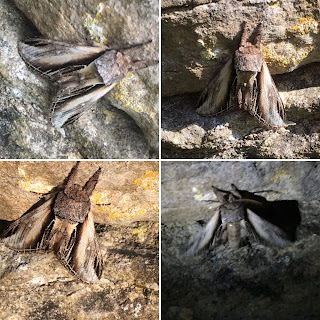The first was this Swallow Prominent on a garden wall. From top left, the photos show it at 6.35am (coolish sunrise), 3.30pm (very warm sun), 6.45pm (mild evening sunshine before The Archers) and finally 8.50pm when it was finally gearing up for take-off.
The second was that both the male Muslins in the trap had their antennae out, although otherwise apparently inert. Most moths in my experience sheath their antennae. I note from the Townsend, Waring & Lewington that the female Muslin behaves idosyncratically, active by day and sometimes found crawling over foliage. Are the males somehow always on the alert? (Maybe for a nearby daytime female?)





That's an interesting observation about the Muslin Moth, Martin. The male I caught last week also had its antennae out, as did the only example that I photographed in 2019. Thinking about other species, I have caught a few Brindled Beauty that also had their antennae out (including one that was having the feathery-antenna equivalent of a bad hair day), but also a couple of males that had their antennae stowed away.
ReplyDeleteThat's really interesting, Tim I wonder if it does mean that they are somehow on the alert? No doubt we have experts here who can help, or I'll probably do some Googling cos I find antennae fascinating, maybe because we don't have them! All v best M
ReplyDeleteHi Martin,
ReplyDeleteI can recommend the new caterpillar book from Bloomsbury, but when it comes to small green larvae the words "needle" and "haystack" spring to mind!!
The larva has the look of Winter Moth, though I wouldn't be confident enough of the ID to record it as such.
ReplyDelete